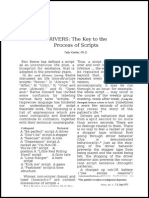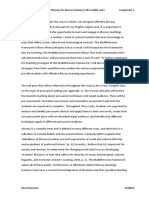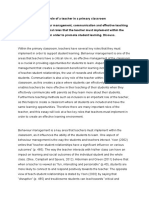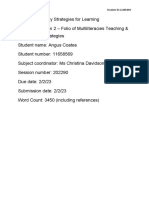Shapes Lesson Sequence
Uploaded by
api-282152955Shapes Lesson Sequence
Uploaded by
api-282152955Lesson Sequence
Subject: 2D and 3D Shapes in the Environment
Year:
Term: 2
LESSON 1
Foundation
Learning Intention: Ability to name two-dimensional and three-dimensional shapes
Differentiation:
Assessment:
Link to AusVELS:
Activity:
Extension Focus on
three dimensional
shapes, sides and
corners.
Diagnostic assessment
through a brainstorm
to determine students
knowledge
Lower Focus on only
two dimensional shapes
Observations of
students prior
knowledge of shapes
Sort, describe and
name familiar twodimensional shapes
and threedimensional objects
in the environment
(ACMMG009)
Identify some
features of texts
including events
and characters and
retell events from a
text (ACELT1578)
Discuss with students and define the terms two-dimensional and three-dimensional shapes.
Discuss shapes, which students should already know (square, circle, rectangle, triangle)
from portfolio assessment task.
Extend on prior knowledge by discussing a sphere and cube. Compare with a circle and
square
Brainstorm with students what they already know about shapes, where they see shapes etc.
Read picture storybook about shapes The Greedy Triangle
Discuss the key aspects of the book.
What happened in the story, what shapes did we see?
Summarise lesson with students. Discussing the shapes and difference between 2D and 3D
shapes.
LESSON 2
Resources: http://www.justbooksreadaloud.com/ReadToMe.php?vid=GreedyTriangle
Learning Intention: Recognise that different shapes are described differently
Differentiation:
Activity:
Extension - Once
students have learnt
each shape use
descriptions such as
this shape has four
sides.
Lower Pair students up.
Ask students what shapes they discussed in the lesson prior
Ask students to sit in a circle on the floor and one at a time, take a shape (square, circle,
rectangle, triangle, sphere or cube). Describe the shape and say its name to the class.
Pass the shape to one of the students and ask them to say the name of the shape then pass it to
the person next to them, this is repeated around the circle.
Take the next shape and repeat above steps naming all the shapes being explored in this unit.
Shape Twister Students spread out around the classroom. Shapes are placed around the
classroom where students can see them. The teacher says the name of a shape and the students
are to walk to the area of the room where the shape is.
Finish activity with a Pair/Share where students discuss one thing they learnt from todays lesson.
Assessment:
Link to AusVELS:
Observations of
students ability to
connect shape with its
name.
Sort, describe and
name familiar twodimensional shapes
and threedimensional objects
in the environment
(ACMMG009)
LESSON 3
Resources: Models of shapes
Learning Intention: Recognise that shapes can be seen in the environment
Activity:
Begin the lesson by showing students different pieces of paper cut in different shapes.
Ask students what animal or object has that shape
Prompt students (A dog with spots, wheels on a bus etc.)
Tell students you want to make a picture of a house but you only have circles, squares, triangles
and rectangles. Ask students which shapes they would use. Display on whiteboard.
Introduce craft activity to students students will use different shapes of paper and glue to create
a picture. Students will then be expected to write a sentence about their drawing. Students will be
provided with a worksheet to create their picture on.
The teacher will write the name of the shapes on the board to assist students with their
vocabulary
Student Gallery Students walk around the room and observe each others work ensuring they do
not touch anyone elses.
Resources: Worksheet
Paper shapes
Differentiation:
Extension Write more
than one sentence on
their picture.
Lower Teacher can
assist by scribing what
the student has created
in their picture
Assessment:
Students ability to
describe the shapes
they have used in their
picture.
Students writing ability.
Letter formations and
letter-sound
associations
Link to AusVELS:
Sort, describe and
name familiar twodimensional shapes
and threedimensional objects
in the environment
(ACMMG009)
Create short texts to
explore, record and
report ideas and
events using
familiar words and
beginning writing
knowledge
(ACELY1651)
LESSON 4
Learning Intention: Create connections between shapes and the environment
Differentiation:
Activity:
Assessment:
Teacher explains to students she has found a treasure box in her house and there are some
special items in it.
Teacher pulls out an item and asks students what it is. Teacher uses prompting questions to make
students consider the shapes in that particular object
How do you know what it is?
Describe what it looks like?
What shapes can you see?
Teacher repeats the above steps for each of the items in her treasure box
Whole class discussion on the shapes they found in the treasure box
Observations of
students ability to
describe the shapes in
different objects
Link to AusVELS:
Sort, describe and
name familiar twodimensional shapes
and threedimensional objects
in the environment
(ACMMG009)
LESSON 5
Resources: Treasure box containing objects
Learning Intention: Students will be able to recognise and sort objects based on their
shape
Activity:
Differentiation:
Extension students
can add their own
objects to the jar
Lower Only sort 2D
shapes
Class brainstorm on the different shapes which they know
Compare this brainstorm with the one at the beginning of the sequence to explore
students learning
Link to previous lesson by telling students more objects have been found which need to be sorted.
Teacher explains the activity and tells students that they must do their best to sort the different
items according to their shape.
Teacher provides sample on whiteboard of to sort shapes
Students each receive worksheet and go to their table to sort objects
Once completed students wait for teacher to mark off their work, provide feedback and assistance
if necessary
Students return to the floor and participate in thumbs up/down closure activity
Teacher asks questions such as did you enjoy activities and students put either thumb up
or down
Was this task hard?
Resources: Assessment Worksheet
Glue
Scissors
Coloured Pencils
Criteria to mark students progress
Assessment:
Performance
assessment task of
students ability to
recognise shapes in the
environment. Criteria to
determine students
learning progress of
this sequence.
Link to AusVELS:
Sort, describe and
name familiar twodimensional shapes
and threedimensional objects
in the environment
(ACMMG009)
You might also like
- Rational Number Assessment Task 1 - Breanna LevesqueNo ratings yetRational Number Assessment Task 1 - Breanna Levesque5 pages
- 7.McLeod & Genereux, 2008 - Predicting The Acceptability and Likelihood of Lying - The Interaction of Personality and Type of Lies PDFNo ratings yet7.McLeod & Genereux, 2008 - Predicting The Acceptability and Likelihood of Lying - The Interaction of Personality and Type of Lies PDF6 pages
- Geo Assignment 1 - Final Copy - Nicolette ByronNo ratings yetGeo Assignment 1 - Final Copy - Nicolette Byron51 pages
- Msed Elementary Portfolio Project - Kristin D100% (1)Msed Elementary Portfolio Project - Kristin D145 pages
- Task 1: Planning Commentary: 1. Central FocusNo ratings yetTask 1: Planning Commentary: 1. Central Focus4 pages
- Mapping the Way from Teacher Preparation to edTPA® Completion: A Guide for Secondary Education CandidatesFrom EverandMapping the Way from Teacher Preparation to edTPA® Completion: A Guide for Secondary Education CandidatesNo ratings yet
- Vapa Di Lesson Plan Template Pre-Tpa SP 11 Rough DraftNo ratings yetVapa Di Lesson Plan Template Pre-Tpa SP 11 Rough Draft6 pages
- West Virginia State University College of Professional Studies: Department of Education Lesson PlanNo ratings yetWest Virginia State University College of Professional Studies: Department of Education Lesson Plan3 pages
- EEE 482 Introduction To State-Space Methods (3) (F)No ratings yetEEE 482 Introduction To State-Space Methods (3) (F)2 pages
- Factors Affecting Project Implementation Amongst100% (2)Factors Affecting Project Implementation Amongst48 pages
- Intimacy and Healthy Affective Maturaity - Fa-Winter09bNo ratings yetIntimacy and Healthy Affective Maturaity - Fa-Winter09b9 pages
- Lesson 2-5: Proving Angles Congruent: Geometric ProofsNo ratings yetLesson 2-5: Proving Angles Congruent: Geometric Proofs5 pages
- Significance of Influence Strategies and Leadership Styles of Managerial ProfessionalsNo ratings yetSignificance of Influence Strategies and Leadership Styles of Managerial Professionals9 pages
- Ames, The Origin of Uses and Trusts, PDFNo ratings yetAmes, The Origin of Uses and Trusts, PDF15 pages
- Community Conversations Immigration ToolkitNo ratings yetCommunity Conversations Immigration Toolkit10 pages
- Bba101 - General Principles of ManagementNo ratings yetBba101 - General Principles of Management1 page
- Philosophical Assumptions For Qualitative Research 1No ratings yetPhilosophical Assumptions For Qualitative Research 17 pages
- Essential Bibliography For English Language Teaching and Applied Linguistics PDFNo ratings yetEssential Bibliography For English Language Teaching and Applied Linguistics PDF149 pages

























































































